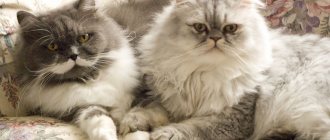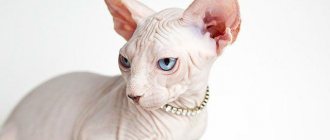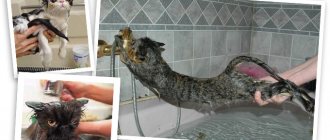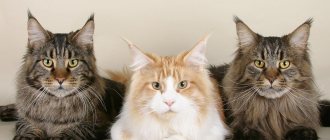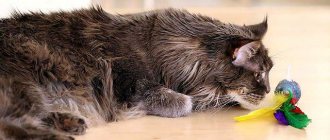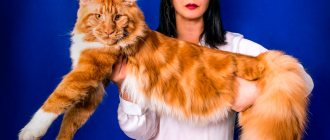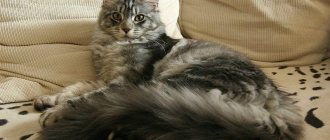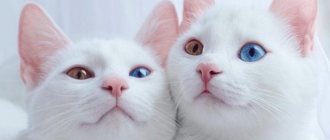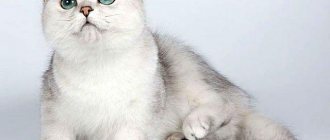Good day to all!
Let's talk about scallops? But not about these “tools” for caring for one’s appearance, which Nature has already endowed all the little ones with:
- the main one is the grater tongue;
- sometimes claws help out;
- those walking in the yard “by themselves” have kisul - “improvised means” in the form of tree trunks - to rub sideways and even grass - to lie on the back, i.e. easily throwing off the shedding tufts.
But domestic cats are “on their own” only during walks! And, since they live with us under the same roof, the point of hygiene in the “rules of life” for them is much more strict than for their yard, unfortunately homeless, brothers. In this matter, the owner comes to the aid of his furry cleanie.
Why are they?
Cat combs for combing fur were invented by man to keep a pet’s coat impeccably clean, beautiful and in order. And if a cat is taught from childhood to the procedure of combing (and also washing his eyes and cleaning his ears) with affection and play, then he will really love this care. And it will even ask itself!
But if you don’t teach it, then don’t be surprised. such a reaction:
This “brush” will “comb” anyone’s hair
How to train?
Very simple! For this:
- pre-bathe the kitten with shampoo (without conditioner), once it’s dry, sit it side by side - preferably on a litter, and while combing, communicate in a quiet and gentle voice - let it be pleasant;
- increase the time of toileting behind a fur coat gradually, avoiding the moment when the procedure ceases to be “a thrill”, so that he does not want to subsequently “beautify” with the help of the owner;
- choose the same time for care, forming an addiction to the daily routine; For those with a short coat, once a day is enough, and for those with a long coat, twice.
Any damage or inflammation of the skin is a contraindication for the procedure!
Types of scratchers and how to choose
We choose depending on:
- intended for: combing wool, undercoat, tangles or fleas; trimmer; grooming; massage; for thinning and shortening;
- fur lengths for: fluffy long-haired, smooth-haired, wire-haired or short-haired species;
- breeds for: British, Scottish and medium breeds;
- devices: with rotating or sharpened or very frequent teeth; glove; mitten; comb-rake; metal;
- from the manufacturer: for example, Keller, Artero.
Briefly about the main types
COMB - with teeth of different heights and frequencies (must have blunt tips!) - available for any length; needed for untangling matted wool and tangles; and the flea comb has very frequent teeth.
A comb with rotating teeth is more effective than a simple one. But don't use it for
very long fur, because hairs can get wrapped up and be pulled out by the roots!
Slicker (slicker) is a “cruel” tool that tears out the undercoat! It is only used to raise the pile on the “pants”, “collar” and tail. Not for tangles and not for combing! But only for healthy and first combed wool with a sparse comb, and no more than twice a week during molting and once after it ends, and daily - it’s impossible!
The length of the teeth is more frequent and longer, the thicker the undercoat and the longer the guard hair. Not for short-haired people!
FURMINATOR is a favorite of cats and... a “jack of all trades”, because it combines: a simple comb, a comb for trimming (for manually removing undercoat), and a slicker brush; Available for different lengths of pile.
Operating principle: the fluff clings to the notches on the comb teeth and is brought out, while the guard hair does not cling and remains in place.
The undercoat is formed from 2-3 additional downy hairs growing from the same follicle as the guard hair. During molting, they die and fall out, and new ones grow in their place. The Furminator extracts dead and no longer needed fur “perfectly”!
Intimate question
A cat's litter box is, at first glance, a simple and unassuming item, but not only the order in the house, but also the well-being of the animal depends on it. If a cat is uncomfortable fulfilling its natural needs, it becomes nervous, which affects its behavior and well-being.
It is better to buy a toilet for giant coons, the largest one, open or with a mesh. A toilet-house is convenient for owners, but not every animal recognizes such a design, and the filler in it takes longer to dry than in open trays.
When picking up a kitten from the nursery, it wouldn’t hurt to get acquainted with the “common areas” to which the little Maine Coon was accustomed from the first weeks of life, and buy the same tray and filler for home - at least for the first time, while the baby gets used to the new place . You can also take some used litter with you and put it in a tray at home - so that it is easier for the kitten to understand by smell where the toilet is in its new home.
Wood filler is suitable for Maine Coons - it absorbs moisture well and absorbs odors, and is also inexpensive. The only drawback is that the filler is light and spills out of an open tray if the cat likes to dig into it. Expensive silica gel litters are easy to clean, require replacement once a month, and retain odors, but many cats do not like them because of the crunching noise they make. Clumping litters are good if there are one or two cats in the house. They are environmentally friendly, economical, they can be thrown into the sewer, but if there are a lot of animals, cats will trample the lumps and spread dirt on their paws.
Caring for a Maine Coon is not only about caring for the appearance and health of the pet, but also moments of communication with an animal that craves attention. Even if some procedures are not very pleasant for a cat, but if a person and his pet trust each other, neither bathing, nor trimming nails, nor taking pills will become an insoluble problem.
For short-haired representatives
Plush and thick wool, for example, the British shed heavily, for care you need:
- metal comb with frequent thick teeth;
- at the end of the procedure, use a natural brush (or rubber mitten).
- comb-comb;
- a brush with sparsely spaced bristles.
Bengal, toyger, ocicat should be combed 2-3 times a week, in the “arsenal”:
- metal comb with densely spaced thick teeth;
- then the mitten;
- At the end, wipe with a piece of suede for shine.
And here the powder is harmful!
What care products and items would you like to buy for your Maine Coon?
List of items that will be needed to care for cats: - a slicker brush, - metal combs with rare (for kittens) and fine (for adult cats) teeth, - a metal comb for removing undercoat, or as it is also called a “grooming rake”, - double-sided natural bristle brush, - shampoo for long-haired cats, - bath towel, - guillotine nail clipper, - toothbrush and toothpaste for animals, - ear cleaner or petroleum jelly, - cotton wool, gauze swabs and napkins.
And further…
But what should your animal do if he can never, ever go for a walk?
And you... replace his tree trunks and grass - natural “self-groomers” - with homemade or purchased models:
Read about them in our article “There are different types of scratchers for cats.” Good luck to everyone!
Maine Coons need regular coat care: bathing and constant brushing will prevent the appearance of hated tangles and make the coat smooth and silky. The animal's fur reaches its greatest length on the neck, tail, scruff and hind legs.
Maine Coon owners should choose the right brushes and combs for combing, shampoos and grooming devices - this will help maintain not only the beautiful appearance, but also the health of their pet.
Keeping a Maine Coon in an apartment
Cats of this breed are quite large and very active. They need ample living space. A small apartment does not suit them at all. Although exceptions are possible. To keep a Maine Coon in an apartment, you need to create comfortable living conditions. Let's look at some tips for an apartment:
- A place to eat. One bowl for clean water, the second for dry food or natural food, the third for canned or semi-liquid food;
- Tray. You need two of them for a kitten. It is better to choose clumping or granular filler.
- Pet corner. It is necessary to allocate a place where there should be a house for the cat. There he will rest and sleep. You also need to purchase a scratching post. It is necessary to keep the furniture intact. To entertain your cat, you need to buy a couple of toys with a rope or spring.
If all the conditions and rules are met, the pet will feel comfortable. These rules are not very complicated. If the owner creates comfortable conditions for the Maine Coon, the cat will definitely respond with love.
Maine Coon Shedding
Shedding in the Maine Coon breed can occur both due to health problems and as a result of natural factors.
Interesting! Shedding is periodic, since each hair lives on average for about a month. If you do not brush your Maine Coon, the dead hair will not be removed, which will cause the coat to become matted.
Seasonal
Maine Coons living in apartments are not affected by sudden changes in temperature, so their shedding is no longer seasonal. Most often it occurs in mid-spring or summer, but due to poor ventilation of the room or unbalanced nutrition, this process can begin at other times.
Age
Maine Coon grooming should begin from childhood, since the pet sheds as it grows.
At the age of six months to a year, the kitten's fur becomes thicker and coarser - at this time, active loss of the baby's undercoat occurs, and the Maine Coon needs to be scratched with a comb or comb at least once a week.
Important! Accustoming your Maine Coon to combing should begin early and gradually, otherwise in the future this procedure will cause aggression in the animal or cause prolonged stress.
Age-related molting can last up to two years - at this time, the body, due to restructuring, needs a large amount of vitamins and beneficial microelements. A deficiency of these substances can cause severe hair loss and deterioration in its appearance.
Features of training a Maine Coon to comb
These cats begin to shed from childhood, when their baby fur changes to adult fur.
That is why it is necessary to accustom a Maine Coon to combing from childhood, so that the kitten learns that this is a necessary procedure and then does not have to figure out how to comb out the Maine Coon’s tangles.
Usually the first shedding begins when the kitten is about six months old or a little older, and can continue even until he is two years old.
This is a normal and natural process, but it means that now you will have to brush it at least once a week.
For those who want to know how to brush a Maine Coon at home, it is important to remember that the kitten must be taught to perceive the process as pleasant.
Then the adult animal will know that it will be released, and will calmly react to the owner’s desire to comb it.
Normal seasonal shedding lasts from September to November, and then from February to April, but for indoor cats this schedule often gets disrupted.
In addition, one hair lives on them for no more than a month, which means they are constantly being replaced and renewed.
Your Maine Coon will have to be brushed constantly, so he should enjoy the process. Then you won’t have to decide how to comb your Maine Coon if he’s against it. It may be worth offering him a treat if you can't cope otherwise.
Another option is to use a special mitten so that the animal thinks that it is just being petted.
Care during shedding
The shedding period can last from 25 to 45 months - during this time it is necessary to regularly use a high-quality brush to care for your Maine Coon. If you ignore brushing, the animal may eat the hair. This will negatively affect the functioning of the gastrointestinal tract.
Interesting! Males shed more heavily than male cats.
In addition to using a comb, bathing and blow-drying, as well as introducing vitamins into the diet, will help ease the shedding process.
The need to wash Maine Coons and cosmetics
The Maine Coon takes care of the cleanliness of its coat by washing itself frequently. Water procedures using shampoo must be carried out before exhibitions, but in normal times it is enough to wash the cat approximately once every six months, preferably during the molting period - this makes it easier to get rid of fallen hairs.
Before the exhibition, the pet is washed with special products - degreasing (for cats it is especially important to clean the tail, near which the glands are located), cleansing, coloring and texturizing, then dried with towels and a hairdryer.
How to care for Maine Coon fur
Everyday care for your pet's coat includes several steps that require little time and minimal preparation.
Combing
To brush your cat you will need 2 combs:
- with sparse, long teeth will easily remove tangled hairballs;
- with frequent but shorter teeth will remove the remains of fallen hair and dirt.
Combing is carried out from the back of the head towards the tail.
You should not buy:
- furminator, designed for grooming dogs;
- slicker, as it can cause microtrauma and severe pain to the pet.
It is also allowed to use rotating comb brushes with rounded metal teeth to care for a cat's fur: they are well suited for combing very long hair that is prone to tangles.
During non-shedding periods, it is recommended to use the comb twice a week.
Bathing and cosmetics
When swimming, you should adhere to a number of rules:
- heat the water to 38 degrees;
- protect the bathroom from drafts;
- Place a small towel at the bottom of the bath and constantly stroke your pet - this will reduce stress levels;
- Do not allow water to get into the cat’s ears and eyes.
You should bathe your pet during shedding, to facilitate it, and during the recovery period after diseases that did not allow the animal to fully care for its coat on its own.
During bathing, special shampoos for long-haired pets are used. Finally, the fur coat is rinsed with good pressure of warm water in the direction of hair growth.
The washed pet should be carefully dried with a soft towel - active friction can greatly tangle the wet fur. If the animal is in the period of molting, it should be dried with a hairdryer; in other cases, the cat should be allowed to lick itself. And only after that you can comb the Maine Coon with a comb.
Fighting tangles
It is not recommended to untangle the tangles found by hand or with a comb; they must be carefully cut out with nail scissors. Most often, the hair gets very tangled in the tail, belly, neck and hind legs.
The main cause of tangles is a skin fungus, which is easily identified by the presence of dandruff. In such a case, it is necessary to visit a veterinary clinic so that a specialist can prescribe antifungal therapy. To prevent the appearance of tangles, it is recommended not to forget about regular use of a comb.
Poor nutrition, lack of hygiene and deteriorating health primarily affect the condition of the animal's coat: it becomes brittle, loses its shine and falls out. To avoid negative consequences, you should carefully monitor your pet’s diet, do not neglect the described rules of care, and conduct preventive examinations with a veterinarian.
Eyes, ears, teeth and claws - these are my documents
It is advisable to regularly inspect your Maine Coon's teeth to ensure that tartar does not form. If your cat eats dry food, you can brush its teeth once every two months; if it eats natural food, you can brush its teeth at least once a month. Coonam's teeth are cleaned with a special paste for cats using a children's toothbrush.
Caring for the eyes of a healthy cat is usually limited to daily wiping with a piece of cotton wool. If discharge appears, you can wipe your eyes with tea or a weak solution of boric acid.
The inside of a large weasel ear should be pink, clean, and free of black coating. If wax builds up, it can be gently removed with a cotton swab and Vaseline.
If the Maine Coon is not supposed to be present at the exhibition today or tomorrow, it is better not to touch the claws - he will take care of their length himself using a scratching post. But if the claws have grown a lot, they can be trimmed with a special nail clipper or tweezers, very carefully, cutting off only the tip, strictly across, otherwise you can hit a blood vessel.
Particular care must be taken in shortening pigmented claws - the blood vessels are not visible through them, in addition, it should be remembered that the claws on the front paws are longer than on the hind paws. It is better to carry out the procedure together - one person holds the cat, and the other shortens the claws. After this cosmetic operation, you can polish the claws with a nail file. If an animal breaks a claw, it must be trimmed: a broken end can injure the cat's paw.
Types of combs for cats
Tools for caring for a cat can be divided into combs, brushes and other devices, which include furminators and tangle cutters.
Combs or combs
- Combs with rare and frequent teeth. Necessary for primary combing of wool. Sometimes both types are combined in one device;
- Flea comb. It is distinguished by very frequent teeth and is intended for the care of paws and muzzle, where the hairs are short;
- Comb with teeth of different levels. Used for combing cats with long hair and semi-long hair with a thick undercoat;
- Rake comb. Allows you to carefully care for the fur without causing discomfort to the animal.
Brushes
- With metal teeth. Necessary for combing areas with long and rich hair (collar, fluffy pants), carefully unraveling tangles;
- With natural bristles. Helps when using dry shampoo or powder - applies, distributes and eliminates residue. Also intended for massage;
- Silicone glove or brush with hand attachment. Needed to remove dead hair and massage the skin;
- Slicker, or slicker. It has thin, slightly curved metal teeth. Used for styling tails and fine coats, as well as correcting the condition of the undercoat.
Other tools
- Colt cutter. A metal device with serrated blades. Allows you to carefully remove tangles that cannot be combed;
- Furminator. With its help, dead hairs of the undercoat and awns are combed out. Not intended for cats that regularly participate in exhibitions.
How to choose a comb for a cat?
The set of equipment for grooming depends on the breed of the cat and its coat. The brushes required for a smooth-haired cat may not be suitable for long-haired animals. They will also likely require additional tools.
Combs for long-haired cats
The most striking example of a cat with long hair is the aristocratic Persian. Their rich coat and long hair require frequent and careful grooming. Despite the fact that the coat looks very fluffy, it feels like down to the touch. All hairs are very thin and prone to matting, and the undercoat is completely absent.
To comb Persians you need:
- Combs with teeth of different lengths and frequencies. The use of these tools is the basis of grooming, and it is with them that you should comb your pet;
- Brush with natural bristles. Designed to give the coat an ideal look and remove missing hairs.
The slicker is completely unsuitable for caring for this breed - it injures the skin, tears out fine hair, causes pain and disrupts the hair structure.
Combs for short-haired cats
The plush and loose-fitting coat of the British and Scots requires a completely different approach. They have a well-developed undercoat, equal in length to the guard hair. Despite the fact that these breeds are short-haired, their coat is thick, and the Scots and British are highly susceptible to shedding.
To care for these breeds you need:
- Metal comb with medium-frequency teeth. It is with this that you need to start combing your pet;
- The second stage is a slicker to care for the undercoat and remove excess hairs;
- The procedure is completed with the help of a massage brush, which gently massages the animal’s body and smoothes the fur.
Cats are proud and capricious creatures. Not everyone can easily tolerate manipulation of wool, especially if it has become matted. Royal Groom products for cats simplify the combing process and remove the electrified effect. Regular use of sprays prevents tangles and has a moisturizing effect.
How to choose a brush for combing
The answer to the question of which comb is best to brush your Maine Coon is quite simple. But first of all, you need to know what not to do.
In order to cope with a Maine Coon, you will not need:
When choosing which comb to comb your Maine Coon, it is better to avoid brushes with plastic handles - they accumulate static, and cats don’t like that.
Wooden handles will be less problematic, but such brushes wear out quickly and have to be replaced.
To care for your fur you only need a few items:
Instead of scissors, you can also use a special comb with a sharp edge, which allows you to quickly deal with the problem right in the process of combing. On the other hand, you need to use it carefully.
The animal's skin can be easily touched and injured, especially if it is actively moving and unhappy with the process.
Therefore, this option is suitable only for those Maine Coons who sit quietly while their owners take care of their hair.
If your pet is shedding heavily, you can run a rubber brush with short, triangular teeth through its fur before using a wide-tooth comb.
It will collect fallen hairs from the very surface. It can also be used at the very end to give shape to the combed wool.
To care for your Maine Coon's coat, you can also use various care products: anti-tangle sprays and powder, detangling shampoos and others.
Source
